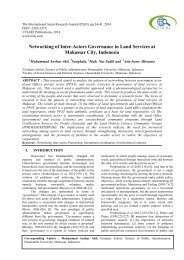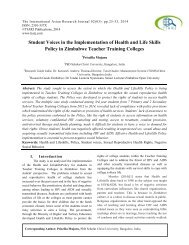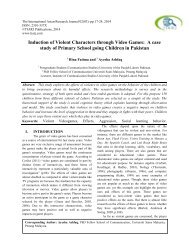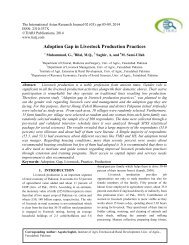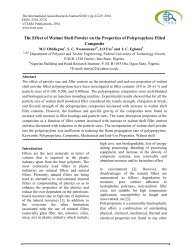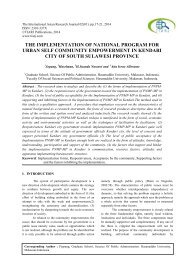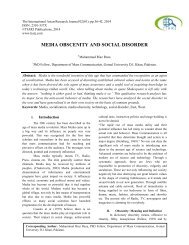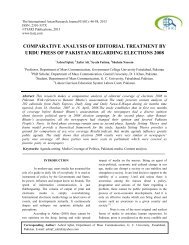VARIATIONS OF HEPATIC VEINS: STUDY ON CADAVERS
Create successful ePaper yourself
Turn your PDF publications into a flip-book with our unique Google optimized e-Paper software.
The International Asian Research Journal 02 (02): 41-45, 2014<br />
technique of injection-corrosion. The corrosion cast<br />
methodology used has been<br />
reported on previously in detail (Ravnik et al. 1995).<br />
Acrylate monomers (acrylate powder and liquid,<br />
Polirepar S, Polident), used as prosthetic material in<br />
dentistry, were mixed and used for injection [7]. A<br />
polyurethane pigmentary paste of various colours<br />
was added to the mass, which was then injected into<br />
liver structures. The preparations, placed in a plastic<br />
mould of the upper part of the abdominal cavity,<br />
were put in a hot bath at +45ºC, where the injected<br />
mass completely polymerized in approximately 20-<br />
30min. After corrosion in hydrochloric acid, the cast<br />
of the vessels allowed study of the arrangement of the<br />
intermediate and left hepatic vv., measurement of the<br />
frequency of a common trunk and its length, noting<br />
the pattern of the collateral vv. The intermediate and<br />
left hepatic vv. weredistributed according to the<br />
classification of Nakamura [8]. The biometric of the<br />
hepatic vv. and the IVC was studied by measurement<br />
with a bougie calibrated on 40 livers in situ. The<br />
length of the common trunk was measured between<br />
the junction of the intermediate and left hepatic vv.<br />
and the ostium of this trunk in the IVC [5,9]. The<br />
diameter of the IVC was measured at its passage<br />
through the diaphragm.<br />
III. RESULTS<br />
A common trunk was present in 31 of the 40<br />
cases (77.5%). The result of the morphologic stu dy<br />
are given in Table 1 (Fig. 1A-E). In 9 cases (22.5%),<br />
the intermediate hepatic and left hepatic veins ended<br />
separately in the inferior vena cava. A type was in 3<br />
of the 40 cases (7.5%), B type in 11 (27.5%), C type<br />
in 12 (30%), D type in 5 (12.5), E type in 9 (22.5) .B,<br />
C types were present in the majority of all cases.<br />
The length of the common trunk varied from 5.5±2.1<br />
mm. The diameter of the new ostium created by<br />
section at 5 cm proximal to the junction of the<br />
intermediate and left hepatic vv. was 19.0±3.37 mm.<br />
That of the IVC at its diaphragmatic passage was<br />
23.6±2.72. However, the diameter of the actual<br />
ostium of the common trunk at its termination in the<br />
IVC was 16.09±3.32 mm.The result are given in<br />
Table 2.<br />
Opening patterns of intermediate and left<br />
hepatic veins, we observed 9/40 (22.5%) cases of<br />
single openings, followed by double openings 23/40<br />
(57.5%), triple openings 8/40 (20%).<br />
IV. DISCUSSI<strong>ON</strong><br />
The literature of the last years more and<br />
more indicates the importance of the hepatic veins in<br />
liver surgery, especially in living related liver<br />
transplantation [10]. This study was to classify the<br />
variations of the common trunk of the intermediate<br />
and left hepatic veins, to determine the frequency of<br />
each type, to analyze the intermediate and left hepatic<br />
veins inflow into the inferior vena cava (IVC).<br />
The diameter of the intermediate hepatic and left<br />
hepatic veins averaged 8.68±1.51mm, and<br />
8.33±1.22 mm, respectively. These values were<br />
similar to the 48.7±1.8 mm and 8.6±2.0 mm<br />
mentioned by Wind et al, but slightly smaller than the<br />
10.0±2.5 mm and 10.7±2.3 mm, respectively<br />
mentioned by Jose Roberto Ortale et al [6]. The<br />
frequency of 77.5% we observed for the confluence<br />
of the intermediate hepatic vein with the left vein to<br />
form a common trunk was within the range (50% -<br />
95%) reported by others [10,11].<br />
The length of this trunk was higher than 9.5<br />
mm in 10% of the cases of the IVC. This frequency<br />
was 9.4% in the cases reported by Wind et al, 10% in<br />
those reported by Jose Roberto Ortale et al, and 3.3%<br />
in those reported by Honda [6,12]. Several<br />
classifications based on the morphology of the<br />
common trunk have been described. Masselot and<br />
Leborgneproposed a simple classification into 3 types<br />
based solely on the length of the common trunk<br />
(common trunk short, long or absent) [10]. This<br />
classification is not sufficient to systematize all the<br />
varieties of common trunk that exits. Nakamura<br />
described a classification based on the branching of<br />
the intermediate and left hepatic vv. less than 1 cm<br />
from the IVC. Indeed, for this author 1 cm is the<br />
minimum length allowing control of the vein [5,8].<br />
Type A includes common trunks of 1 cm or more not<br />
receiving a branch in its last cm. Type B includes<br />
common trunks combined with two branches less<br />
than 1 cm from the IVC. Type C includes common<br />
trunk having three branches less than 1 cm from the<br />
IVC. Type D has four branches less than 1 cm away.<br />
Type E includes cases where there is no common<br />
trunk present.Of our 40 cases, 3 (7.5%) were type A,<br />
11 (27.5%) were B type, 12 (30%) were C type, 5<br />
(12.5%) were D type. The respective values reported<br />
by Wind et al. for 64 cases were: 6 (9.4%) were A, 25<br />
(39.06%) were B, 16 (25%) C, 7 (10.94%) were D.<br />
42




